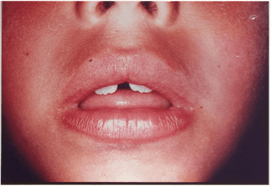Are You Ignoring These Oral Health Symptoms In Your Children?
Throughout infancy, healthy teeth are important. Good oral habits help your child have cavity- free teeth without complications, giving them a smile they are proud of once they’re older. But too often, parents while focusing on their child’s physical health fail to pay adequate attention to oral health. I often hear from my patients that they are simply not aware of what to look out for. So here I have shared some symptoms and habits that are important to catch and treat at an early age.
As a general rule, you should regularly inspect your child’s teeth and pay close attention to any changes in their oral habits, teeth and gums.

Discolouration in Teeth
If you have noticed white chalky spots or a light brown colour discolouration in your child’s teeth, it could be a sign of tooth decay or cavities. As the cavities worsen, there is more darkening of the tooth colour and you may even notice a hole appear. Your child may experience symptoms such as sensitivity to sweets and cold drinks.
If left undetected or untreated, tooth decay in children or toddlers can cause severe pain, infection, tooth loss, and even affect the growth of permanent teeth.
Milk teeth cavities should not be ignored. Many parents feel that these teeth would eventually fall so no need to fill these cavities. But that’s a mistaken concept. Milk teeth need to be preserved and kept healthy till their permanent counterparts erupt. If for some reason, the milk tooth needs to be removed prematurely, your dentist can decide on giving you a space maintainer to maintain the space for the permanent teeth to erupt in the future .
Mouth Breathing
If your child breathes from their mouth, or has a resting open mouth posture, it may seem like a cute little quirk and something you assume they will grow out of. But mouth breathing can turn into a habit that can have serious health and development effects. Mouth breathing can lead to long term issues like speech impediments, improper facial growth and development, and sleep apnea. Untreated mouth breathing leads to development of long, narrow faces with crooked teeth, receded jaw, and an increased incidence of cavities and gum problems.

Thumb Sucking

This is a common habit in little children. Babies have a natural reflex for rooting and sucking, which can cause them to put their thumbs or fingers into their mouths. (BTW, did you know that sometimes babies do this in the womb too!). Thumb sucking soothes the child and makes them feel secure. Usually this habit fades away in the toddler years.
However, if your child continues this habit as they grow older (beyond age 5), it can affect the palate (the roof of the mouth) or how the teeth line up. It is a good idea to have your child visit with the dentist. We regularly advise children on good dental habits, and often this one-on-one talk is effective. If necessary, we might use interventions like a special mouth guard or other dental appliance that interferes with sucking.
Tongue Thrusting

Have you noticed your child rest their tongue in an imperfect position while sleeping, swallowing or speaking? Tongue thrust is an orofacial myofunctional disorder (OMD) that can interfere with facial development, skeletal growth and tooth alignment.
Babies have a natural reflex to push their tongue forward when they are fed. But such tongue movement should disappear as they grow older. Children with a tongue thrust habit end up having an elongated face and a drooping jaw as they breathe through their mouth. Some children also have speech problems.
Breaking the habit at an early age is very important. Your dentist may start with suggesting therapy – a range of exercises to correct the child’s swallowing pattern. This therapy can start as early as age 4, and has been shown to be 80% to 90% effective. If therapy is not sufficient, we might also utilise orthodontic appliance to correct tongue thrusting.
Crossbites/ Reverse Bites

Normally, your upper teeth are positioned a little outside the lower teeth in your mouth. But in some children, the two rows of teeth don’t meet correctly. This is a malocclusion, called crossbites or reverse bites. While sometimes genetics play a role in causing this, often crossbites are a result of bad oral habits like tongue thrusting and thumb sucking.
It is important to address this problem as early as possible, before the malocclusion causes long-term dental and other health problems. A misaligned bite can lead to tooth decay, gum disease and stress on the jaw muscles, which leads to headaches and chronic jaw, neck, shoulder and back pain.
Treatment in children can start as early as age 3, and involve behavioral correction therapies. In some cases, depending on the nature and degree of crossbites, we may use specialized orthodontic devices to correct alignment. Remember prevention is the best cure, so a it is important to get regular dental check-ups for your child from an early age.
Severe Malposition of Teeth or Jaws

Irregular or improper positioning of teeth can lead to serious problems. Teeth are not able to perform vital functions if they are misaligned. Alignment of upper teeth is needed to prevent the cheeks and lips from being bitten, while alignment of lower teeth is needed to protect the tongue from being bitten.
Any type of misalignment can lead to issues, and are often caused by external factors and oral habits. Therefore it is important to address any bad oral habits early on, since at a young age habits are easier to correct and can prevent long term dental issues.
There is a common misconception that braces should be put only after all the permanent teeth have erupted. Children should be monitored for excessive malposition of teeth and a visit to an orthodontist should start as early as 7-8 years to intercept a growing problem.





